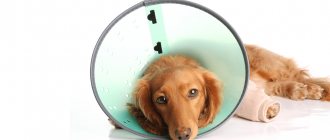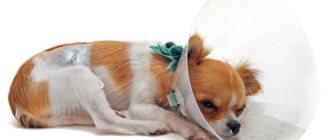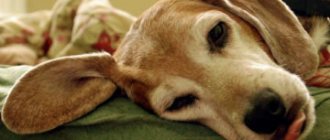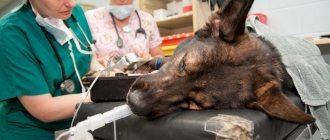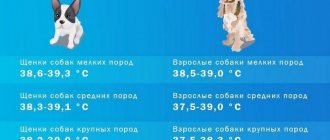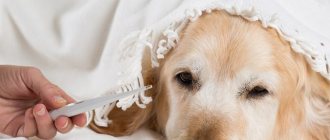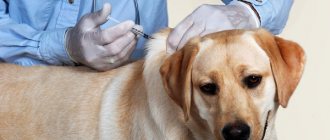Narcosis and its consequences
The most difficult and dangerous thing for the body during surgery is, of course, anesthesia. It is the body’s reaction to the introduction of anesthesia that determines the severity of rehabilitation therapy on the first postoperative day. Add to this the loss of blood, a painful, sometimes extensive wound, and you will understand how difficult it is for an animal to recover after an intervention.
Most often, a pet’s recovery from sleep occurs in a veterinary clinic. It is not without reason that this moment is considered the most crucial and dangerous - if something goes wrong, your beloved friend will need urgent help from specialists, so no matter how much you rush home, wait until your dog opens his eyes. After this, with a sigh of relief, listen or write down all the veterinarian’s recommendations regarding the postoperative period.
It should be remembered that when recovering from deep anesthesia, your pet may experience tremors and anxiety. During transportation home, try as much as possible to calm the animal and be sure to cover it with a warm blanket on the way - this will reduce chills and protect the fresh seam from drafts.
Home care
In addition to the help of your family, your sick pet needs to create special conditions for speedy rehabilitation. The first thing you should take care of is a cozy, dry bedding for him. It should be remembered that for a long time after the operation, jumping and other sudden movements are contraindicated for the dog, so it is better to make a mattress on the floor - any elevation, even a low one, may be beyond the strength of your patient.
Both the period of recovery from anesthesia and the first days after the operation are accompanied by decreased activity of the dog. It may well be that he doesn’t even want to go outside to relieve himself, so it’s best to cover the area with oilcloth, then even emptying yourself won’t take you by surprise. However, there is another danger. Some animals, emerging from a narcotic sleep, become overly excited and active. Make sure that in the room where the dog is kept there are no objects that it could push or fall on itself.
First day
The most difficult are the first days after surgery. The animal may be in great pain or discomfort after surgery. Anesthesia drugs wear off within 24 hours, so strange behavior may occur. Other symptoms may also appear.
Nausea and vomiting
This occurs due to the fact that the activity of peristalsis of the smooth muscles of the gastrointestinal tract is resumed.
Trembling or twitching of limbs
It is noted due to an increase in pressure and residual effects of drugs.
Reduced temperature – 37.5 degrees Celsius
This is due to the fact that under anesthesia all biological processes slow down, including thermoregulation. After some time, the temperature will return to normal.
Slow reaction
The dog may not respond to its name and ignore its favorite toys. The dog's general interest and playfulness will soon be restored.
If symptoms of general malaise persist throughout the day, it is recommended to consult a specialist.
Caring for seams
Caring for postoperative sutures is another important stage of postoperative therapy. Fortunately, such wounds on animals heal especially quickly, like on a dog. This is explained by better tissue regeneration in canines, as well as the absence of suspiciousness and anxiety inherent in a person in such a situation. However, animals, for obvious reasons, follow the recommendations of doctors much worse, and strive to bring dirt into the wound or remove the stitches with their teeth themselves.
To prevent this from happening, protect the incision site with a special post-operative blanket that securely fits the pet’s stomach and chest, tying it around the neck and back. The blanket needs to be changed daily, so it is advisable to have several of these capes and wash them when they get dirty. Particularly proactive patients who believe that they know better than you how to care for sutures can wear the so-called Elizabethan collar - one of the methods of barrier therapy. Thanks to this limiter, the dog will not be able to reach the problem area with its tongue.
Seam processing is also extremely important. It should be carried out 3-5 times a day (more frequent or rare treatment is at the discretion of your veterinarian). It is better to wipe the incision site with disinfectants that do not contain alcohol - chlorhexidine, a medium solution of potassium permanganate or liquid silver in a spray. After treatment, a sterile gauze bandage is applied to the seam, and a blanket is applied on top. If you did everything correctly, after about 10-12 days the wound will completely heal and the stitches will be removed from the body.
If your pet has a catheter in a vein, do not ignore it. Very often, such a tube causes severe swelling of the soft tissues. To prevent this from happening, carefully monitor the dog and, in case of severe swelling, pull the catheter out of the vessel. Another trick that experienced veterinarians are certainly aware of is to install the catheter lower, just above the wrist. It is in this area that it is easily tolerated by the body.
Drug therapy
The first thing you should take care of after some time after arriving home is alleviating the pain that your pet experiences. In most cases, animals can withstand pain, but too much suffering can lead to shock and loss of consciousness, so if the dog shows anxiety, cries or screams, be sure to inject it with an analgesic that your doctor will prescribe.
The second mandatory remedy is antibacterial drugs. To prevent inflammation and the development of complications, your doctor will definitely prescribe you antibiotics. Remember that they need to be injected at strictly defined intervals, otherwise the entire effect of these medications will be negated.
In the first days after surgery, the dog may be prescribed IVs to support the body's cardiac and liver functions. If you are unable to administer the infusion yourself, arrange for a veterinarian to come to your home.
Nutrition
Despite the fact that during and immediately after the operation the dog loses a large amount of strength, you should not immediately provide him with increased feeding. In the first five to seven hours after surgery, especially if the intervention was performed in the abdominal cavity, you should not eat or drink at all. And subsequently, moderation is the best way to recover. After all, the body needs energy to regenerate, which is stupid to spend on processing large volumes of food. The postoperative diet should include fresh, quickly digestible, liquid food, which should be given frequently in small portions.
Often, after the intervention, the dog does not show any appetite at all - you should not force food into it; as soon as its condition improves, the desire to eat will fully manifest itself again.
Fresh water within reach is another important condition for recovery. If your pet does not drink liquids at all, you can gradually inject him with water from a syringe at regular intervals. A drip with saline solution, which retains fluid in the body, will also help prevent dehydration.
Balanced diet
The basic rule of feeding a dog after surgery: the food you feed the dog should be easily digestible so that the body does not spend a lot of energy on digestion. It is necessary to ensure that the dog has enough all nutrients, which is very important for the complete recovery of the body. The dog's diet after surgery must maintain a balance of proteins, fats and carbohydrates . Food should not be too fatty and contain a lot of coarse fiber and grains.
Possible complications
No matter how much we want everything to go well after surgery, sometimes there are complications that you need to be aware of. Why is the postoperative period dangerous, and what complications should owners be prepared for?
- Low body temperature, pale or bluish mucous membranes and cold paw pads require urgent medical attention. As in the case of deep fainting and difficulty breathing, this is a matter of life and death, so no delay is possible.
- If within 24 hours after the intervention the dog does not regain consciousness, or, having fallen asleep, does not wake up for 20 hours or more.
- Convulsions or epileptic seizure, as well as swelling and swelling of the neck and muzzle. Such a reaction may indicate an allergy to a particular drug and requires urgent adjustment of prescriptions and administration of an antihistamine.
- Stool mixed with fresh blood, as well as constant vomiting, including water, which the dog tries to drink. It should be warned that immediately after anesthesia, vomiting occurs once or twice, but if this happens more than 5-6 times, it’s time to sound the alarm.
- Swelling and redness of the wound area, abundant purulent transudate with an unpleasant odor, or bleeding from the suture.
- Lying in one position for a long time, if motor function is impaired after surgery, can lead to bedsores. To prevent this trouble from happening, turn your dog over more often and do not let him lie on a wet bedding. Bedsores themselves can be successfully treated with wound-healing medications and free access of fresh air to the wound (this can be provided by placing a pillow underneath and lifting the affected area of the body).
Doctors themselves and experienced dog owners unanimously say that the most difficult are the first three days after surgery. It is during this period that the risk of complications is quite high, the wound hurts, and the tissues have not yet gotten rid of swelling. Having survived this difficult stage, your pet will be closer to a full recovery every day. And you will readily help him with this, taking care of his comfort and strictly following medical recommendations.
Just recently we had some trouble. As I may have already told you about our Buska, she is a passionate lover of stones. She did not recognize fetch or special toys for dogs from puppyhood, but stones. However, in recent years, the health of her teeth did not allow her to play with her favorite hobbies, so we simply stopped throwing stones for her to “search” and carefully ensured that she did not find them on her own during a walk. Replaced with garden apples or chestnuts.
But on one of her street walks, she finally found the subject of her passion. And everything would have been fine, but, as it turned out, she accidentally swallowed it. For a small dog, the stone turned out to be quite large (and it was lucky that it was not long and had no sharp corners!).
It became clear that something was wrong with Buska when we began to notice problems with stool and even intestinal blockages (the dog did not go to the toilet normally for almost four days.) Before that, nausea and a change in appetite occurred. For the first two days they thought it was the teeth, heart, and liver. But they couldn’t imagine that a smart, adult dog managed to swallow a STONE on the street!
When it became clear that the dog had not walked at all for more than a day, we took her to the clinic, where immediately after the examination she had an ultrasound, and then, in another clinic, an x-ray was taken. During all this time, the stone did not pass too far through the intestines and the doctors wanted to perform the operation on the spot. It was a very difficult decision. Since the dog is not young, to put it mildly, not very healthy and... there is a huge risk that she will not survive the anesthesia. The doctors said that her chances of survival were much greater if she did not undergo surgery and the stone would somehow miraculously pass on its own. But even here there was a great risk to life, since over such a long period of time, all the remaining food inside that did not pass through the stone could begin to rot and. in general, it is clear that death could have occurred due to this.
On top of everything else, there was an unlucky sign - the 22nd. It so happened that in our family, all the animals, reaching their venerable term, died on days in which there was a deuce (I don’t even know how to explain this) - 2, 20, 22. The last one to die was my rat Knopochka - in May. 12th. Therefore, when performing the operation on Busya 22, it was possible to give 99% that she would not survive it.
On the recommendation of our veterinarian, we gave her oil, but there was no effect. And the next day we still went for the operation. Many thanks to the specialists and, first of all, to the SURGEON - an efficient and knowledgeable woman. The operation was successful and without consequences. The stitches were removed a couple of days ago and everything seems to be fine.
The only question that remains is how long it will take for intestinal function to be restored and whether there will be further consequences associated with the operated site. Maybe someone with a pet had a similar situation with intestinal surgery - share your experience! How is everything healing, is there a threat of some consequences?! Thank you very much in advance!
The choice of diet depends on the specific clinical disease. After a stomach illness, fried, salty, canned foods, sweets, flour and bakery products are excluded from the animal’s diet. The basis of the diet should be easily digestible foods.
In the first days of illness after stopping the starvation diet, the animal can prepare low-fat meat broths. Lean beef, chicken, rabbit or turkey are best Pork, lamb and fatty beef should be excluded from the diet. It is worth introducing vegetables into the diet, giving them stewed - pumpkin, zucchini, carrots, turnips, broccoli. It is not recommended to feed potatoes, white cabbage, radishes and greens.
In case of vomiting, the diet should consist of low-fat foods with high nutritional value. Boiled rabbit and chicken meat, boiled eggs, and rice are suitable for this purpose. Food must be in liquid form. For chronic constipation, the diet should be enriched with boiled beets. For regular bowel movements, bran should be given at the rate of 1 tablespoon per 300-400 grams of finished food.
In case of inflammation of the mucous membrane of the digestive tube, accompanied by diarrhea, rice water can be given after a 24-hour fast. Gradually, the animal can be switched to a low-fat diet. It is acceptable to give boiled chicken, boiled eggs with rice, low-fat cottage cheese. In cases of flatulence , avoid whole milk, cabbage, beans, and potatoes. The duration of the therapeutic diet depends on the condition of the dog and the presence of relapses. Often it takes at least 2-3 weeks for normalization.
Dog's temperature
Body temperature is one of the main indicators of the state of the body, not only of the human body, but also of our smaller brothers.
We recommend reading: Ticks at Kurei Photo
A loving owner needs to know that a dog’s normal temperature should be from 38° to 39.3°C. But not everything is so simple, and indicators may vary. For example, the temperature of a small breed puppy will be slightly higher (38.6⁰-39.3⁰) than the temperature of a large breed puppy (38.2⁰-39.0⁰), adult dogs of small breeds have a higher temperature (38.5⁰-39.0⁰) than adult dogs of large breeds (37.4⁰-38.3⁰). Temperature changes, in some cases, may depend on individual characteristics, the sexual cycle, and physiological state. There is no need to worry if your dog's body temperature is slightly elevated in a stressful situation - after a visit to the veterinary clinic or after giving birth.
But it should be remembered that the increase should not be more than 1 degree Celsius. If you deviate from this norm, take a closer look at your pet. Urgent medical care is needed if the temperature is above 41°C - such a high temperature in a dog is dangerous for its life.
Symptoms of fever in a dog
Contrary to popular belief, a dry, wet nose is not an indicator of body temperature. The main symptoms of fever in a dog:
- lethargy;
- lack or decreased appetite;
- increased thirst;
- shiver;
- vomit.
How to measure a dog's temperature?
To know what your dog's normal temperature is, you need to measure it periodically. The dog may not like this manipulation for the first time, but then it will get used to it. Even if you don't do this regularly, if you suspect a temperature, take it before visiting your veterinarian. Most likely, the dog will place more trust in you, its owner, and will endure this procedure in a calm, homely environment with less worry. Every owner should know how to measure a dog's temperature. Temperature is measured rectally. This can be done with a special rectal thermometer, but a regular mercury or electronic thermometer will do just fine. First, prepare the thermometer: reset the readings to zero, lubricate the tip of the thermometer with cream. An electronic thermometer is more convenient - the dog will have to wait only 1 minute, a little more time - measuring the temperature with a mercury thermometer will take 2-3 minutes. Don’t forget to speak kindly to your dog during the procedure, and then treat him to something tasty.
What to do if your dog has a fever?
What should you do if your dog does develop a fever:
- Don't knock it down. Before lowering your dog's temperature, you must first find out what caused this increase. High fever in dogs can be caused by infections, toxins, or vaccinations.
- Contact your veterinarian.
- Wet your dog's fur with cold water or point a fan at him. But such actions should be stopped as soon as the dog’s body temperature drops to 39.5 °C.
- Giving your dog as much water as possible will help prevent dehydration.
- Give medications as prescribed by your doctor.
Low temperature in a dog
A low temperature in a dog is also considered a deviation from the norm. This can happen, for example, after surgery, in which case you need to cover her warmly and be sure to consult a veterinarian. The body temperature of a pregnant dog can also change; before giving birth it drops by one degree compared to the norm (up to 37-37.5 ° C). The normal body temperature of a newborn puppy on the first day is also slightly lower than usual - 33-36 °C, about 15-20 days it will be about 36.5-38 °C. During this period, it is advisable to provide the puppy with optimal conditions. Even short-term hypothermia can lead to a worsening of his condition.
What should you do if your dog does develop a fever:
What to feed your dog after illness
One of the important issues that the owner of a recovering four-legged friend must resolve is the dog’s recovery from illness. In addition to medications, the complex of rehabilitation measures usually includes a therapeutic diet. Proper nutrition, taking into account the specifics of the disease, affects the body on a par with drug treatment.
In some cases, dietary nutrition is the key to the animal’s recovery and the absence of relapses in the future.
Special supplements of vitamin and mineral preparations increase the body's defenses, strengthen the immune system and contribute to the rapid restoration of the animal's strength. A course of probiotics is prescribed by a veterinarian to restore normal digestive function after a course of antibacterial drugs. Water-salt solutions and glucose are often used to maintain vitality.
And here is more information about the causes and treatment of heart attacks in dogs.
Diet after stomach illness
The choice of a particular diet depends on the specific clinical disease found in the pet. As a rule, strict restrictions on food products are prescribed by a veterinarian for diseases of the digestive system. Stomach ulcers, gastritis, inflammatory processes in the intestines, and liver diseases require the owner to strictly follow the instructions of the attending physician. Diet for such diseases is an important part of therapy.
Owners are often interested in what to feed their dog after a stomach illness. On the recommendation of a veterinarian, in case of pathology of the digestive system, fried and canned foods, pickles, sweets, flour and bakery products are excluded from the animal’s diet.
The basis of a sick pet's diet should be easily digestible foods. In the first days of illness after stopping the starvation diet, low-fat meat broths can be prepared for the animal. Lean beef, chicken, rabbit or turkey are best suited for these purposes. Pork, lamb and fatty beef should be excluded from the diet.
Introducing vegetables into the diet will help improve digestion, enrich the body with vitamins and healthy fiber. For stomach diseases, veterinary experts recommend giving your dog stewed vegetables - pumpkin, zucchini, carrots, turnips, broccoli. It is not recommended to feed a sick animal potatoes, white cabbage, radishes and herbs.
If vomiting occurs, your pet's diet should consist of low-fat foods with high nutritional value. Boiled rabbit and chicken meat, boiled eggs, and rice are suitable for this purpose. Food must be in liquid form.
If the disease is associated with the phenomenon of chronic constipation , then the diet should be enriched with boiled beets. For regular bowel movements, a sick pet should be given bran. The fiber-rich product is added at the rate of 1 tablespoon per 300-400 grams of finished food.
In case of inflammation of the mucous membrane of the digestive tube, accompanied by diarrhea , after a 24-hour fasting diet, the sick pet is allowed to give rice water. Gradually, the animal can be switched to a low-fat diet.
It is acceptable to give a sick dog boiled chicken, boiled eggs with rice, and low-fat cottage cheese. In case of flatulence, whole milk, cabbage, beans, and potatoes are completely excluded from the diet. The duration of the therapeutic diet depends on the pet’s condition and the presence of relapses. As a rule, it takes at least 2-3 weeks to restore digestive function.
Diseases of the pancreas , such as pancreatitis, require strict adherence to the instructions of a veterinarian. After a two-day fast, all fatty ingredients – meat, fish and dairy products – are excluded from the sick dog’s diet.
Owners often wonder what to feed their dog after illness. Under no circumstances should you give your pet rich broths. Greens and legumes are also included in the list of foods prohibited for pancreatitis.
You should not feed your dog radishes, radishes, corn, spinach, or sorrel if there are problems with the pancreas. The basis of the diet should be lean meat (chicken, beef), lean fish (cod, pink salmon), boiled vegetables and cereals (rolled oats, buckwheat). It is useful to give your dog low-fat cottage cheese, kefir, fermented baked milk.
A therapeutic diet is also prescribed for liver diseases. The diet of a sick animal should consist of easily digestible foods. Feeding fatty and sour foods is not allowed. The owner must ensure that the products are not over-salted. Smoked and fried ingredients, canned and pickled vegetables are completely excluded from the diet.
How to properly feed a sterilized dog
It is not necessary to feed the dog for one to two days after surgery, depending on the condition of the animal, especially if the pet does not require food.
In the next couple of weeks, the full volume of the daily portion should be divided into a larger number of feedings: if the dog was fed twice a day, transfer it to four meals a day. This will help reduce your daily food requirement and reduce its volume.
Two weeks after surgery, you can gradually return to your usual feeding times. However, it is not necessary to change the dog’s diet.
But the question arises: what to feed a sterilized dog. If the dog was fed dry food before surgery, the pet should be switched to food for sterilized dogs with a reduced fat content. The transition to a new type of food should be done smoothly, replacing part of the usual diet with a new one - starting with 5-10% of the total volume, gradually increasing the percentage of the new food and reducing the usual food. A sudden change in food can cause diarrhea, vomiting, and lead to the development of allergic reactions. A gradual transition to a new type of nutrition allows the body to adapt and absorb the new food well.
If the dog ate natural food, the amount of food rich in carbohydrates should be reduced. A natural diet for a dog should consist of:
- Lean meat: beef, lamb, horse meat, duck, turkey, chicken, rabbit. Meat is protein, a source of energy and strength for the animal; meat should be muscular, but sinewy - it is digested more slowly and, when chewed, helps avoid the appearance of tartar. Chicken can be a strong allergen, especially in the skin, and this meat should be fed with caution and removed if an allergic reaction occurs.
- By-products: liver, kidneys, heart, tripe. Offal contains enzymes necessary for the normal functioning of the gastrointestinal tract. Liver should be present in a dog’s diet in small quantities: if there is an excess of liver in the food, the pet may experience diarrhea. The rumen, or stomach of ruminants, is an essential part of a pet's diet. The tripe should be unpeeled, only well washed - the villi-papillae should be preserved in it, it is advisable to give the stomach along with the fermented contents (if possible) - this is how the dog receives the necessary vitamins from herbs.
- Sea fish. Fish can be included in a dog’s diet infrequently: no more than once a week. It can be any lean fish, along with bones and tripe.
- Eggs: quail (hypoallergenic) or chicken.
- Fermented milk products: low-fat cottage cheese, kefir. Depending on how well fermented milk products are absorbed, they can be given from one to several times a week, replacing one feeding or added to the main portion.
- Fresh vegetables and fruits are sources of fiber, help intestinal function, cleanse the intestines, and are rich in vitamins.
All natural products in an animal’s diet MUST be raw: meat and offal, vegetables, and eggs.
Recovery of a dog after illness
Rehabilitation of a four-legged friend after an illness includes not only the prescription of a therapeutic diet. Diet is also important. Veterinary experts advise feeding a sick animal in fractional portions, 4-5 times a day. For diseases of the digestive system, it is necessary to feed your pet liquid food in the form of soups and broths.
If the dog is weak after an illness, the owner should pay attention to the temperature of the food. Under no circumstances should you feed a sick dog cold or hot foods. You should gradually transfer your pet to medicated dry food, carefully monitoring the general condition of the animal and, in particular, digestion.
If there is diarrhea or constipation, and even more so vomiting, the owner should return to the usual diet for 2-3 days and only then try again.
Postoperative complications in dogs
Postoperative complications in dogs Complications in the postoperative period can be observed after any operation, but more often they develop after extensive, traumatic surgical interventions in the thoracic and abdominal cavities. There are immediate and long-term postoperative periods. In the immediate postoperative period, the most responsible and critical is the early period - the first 2-3 days. At this time, changes that are a direct consequence of surgical trauma and general anesthesia manifest themselves to the maximum extent. This depends on the characteristics of the pathological process, the general condition of the body before surgery, as well as the presence of concomitant diseases, age, the nature of the intervention, complications during operations, the course of anesthesia, etc. The main goals of therapy in the early period are: maintaining cardiovascular activity, external respiration function, combating hypoxia, disturbances of water-electrolyte balance, metabolism and acid-base balance. The postoperative period during operations on the abdominal organs and mammary gland has three features: the development of bronchopulmonary complications, the occurrence of gastrointestinal paresis and a high probability of developing heart failure. Bronchopulmonary complications are caused by hypoventilation of the lungs due to the limitation of diaphragmatic breathing against the background of flatulence and postoperative pain. Complications from the respiratory system include pulmonary atelectasis and pneumonia with a predominant symptom of respiratory failure, which usually develops on days 3-4. X-ray examination is decisive for diagnosis. Treatment is complex: antibiotics, sulfonamides, oxygen therapy, etc. Heart failure as a postoperative complication begins with left ventricular failure, which quickly progresses to failure of both ventricles. The provoking factor is usually the intravenous administration of large quantities of fluid, especially against the background of existing pathologies of the cardiovascular system (cardiosclerosis, aortic disease, etc.). Clinically, heart failure is manifested by cyanosis of visible mucous membranes, tachycardia, bloody sputum, painful enlargement of the liver, etc. If this complication occurs, cardiac glycosides and diuretics are prescribed. As a preventative measure, it is necessary to carry out preoperative preparation (premedication) of patients taking into account the existing pathology and individual determination of the volume of intravenous infusions. Dysfunctions of the gastrointestinal tract usually develop in the first days after surgery, with nausea and vomiting observed. Single vomiting does not require special treatment; in case of repeated vomiting, antiemetic drugs of the phenothiazine series (aminazine, pipolfen, etc.) are used, and the stomach is intubated to evacuate its contents. In case of persistent vomiting, a thin probe is inserted into the stomach to continuously aspirate the contents. It is important to conduct quantitative and qualitative analysis of the removed stomach contents, because mineral salts are released with it. To prevent the development of hypovolemia and water-electrolyte imbalance, it is necessary to carry out intravenous infusion of saline solutions. Symptoms of paresis of the gastrointestinal tract are regurgitation or vomiting of stagnant gastric contents, bloating, stool retention, non-passage of gases, and a sharp weakening of peristaltic sounds. Paresis develops 2-3 days after surgery. To prevent and treat this type of pathology, the next day after surgery, the stomach is intubated 2-3 times a day. Drug stimulation of the motor function of the gastrointestinal tract is used. Gangliobolcators are used: dimecoline, prozerin, pituitrin. Good results are obtained by intravenous administration of electrolytes, especially potassium, which stimulates peristalsis. In emergency cases, gastrostomy is performed using a Foley catheter or various options for intestinal intubation. When tumors are completely removed from the lower mammary glands after surgery, serotomas or hematomas may form. These complications are most often caused by insufficient healing of the subcutaneous layer. When seromas occur, a puncture is performed and the fluid is sucked out with a needle; A pressure bandage is applied for several days. In order to speed up the resorption of hematomas, hot compresses are made three times a day, which are applied for 15 minutes. After incomplete removal of malignant tumors, wound healing is impaired, and progressive swelling of tumor tissues leads to adhesive sealing of the wound edges within a few days. In such cases, the prognosis is unfavorable and the animal is recommended to be euthanized. Relapses are new histologically identical tumors in the same location. They are observed in approximately 20% of cases. Almost half of recurrent tumors are assessed as benign, and reoperation is indicated.
What to do if your animal is very weak
Veterinary experts recommend supporting a pet weakened by illness with the help of rehydrants. For this purpose, the dog can be given Ringer-Locke solution or Regidron. These drugs are effective for diseases accompanied by impaired water-salt balance and dehydration. If the dog’s illness is accompanied by vomiting and diarrhea, then the administration of rehydrants is a mandatory component of the rehabilitation course.
At home, the owner can give the animal vitamin and mineral supplements to restore strength. Multivitamin preparations are prescribed by a veterinarian, taking into account the nature of the illness and the condition of the pet. It is strictly forbidden to use even seemingly harmless vitamins on your own.
In case of severe weakness, the attending physician may recommend that the owner leave the sick pet in a hospital setting. In a specialized institution, veterinary staff will not only look after the dog, but also, if necessary, administer intravenous injections of glucose and rehydrants.
And here is more information about the treatment and rehabilitation of dogs with paralysis.
The key to a quick recovery and restoration of strength after an illness of a four-legged family member is a therapeutic diet. A veterinarian should prescribe one or another type of nutrition, taking into account the specifics of the disease. In some cases, a sick dog needs to be switched from natural feeding to specialized medicinal food.
